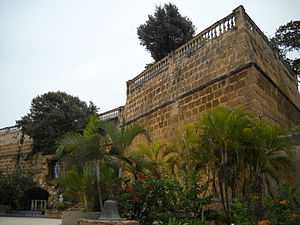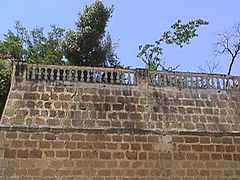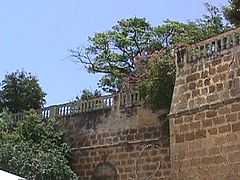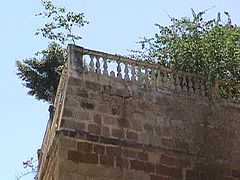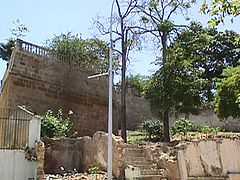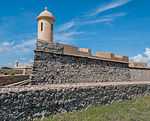Santa María de la Cabeza castle
| Santa María de la Cabeza castle | |
|---|---|
| Cumaná, Venezuela | |
|
Outside walls of the Santa María de la Cabeza castle | |
| Coordinates | 10°27′40″N 64°10′27″W / 10.461094°N 64.17418°W |
| Type | Fortress |
| Site information | |
| Controlled by | State government |
| Open to the public | yes |
| Condition | Ruins |
| Site history | |
| Built | c. 1669–73 |
| Materials | margosa limestone |
Santa María de la Cabeza castle is a colonial castle built in the seventeenth century by the Spanish monarchy in the center of the city of Cumaná, Venezuela. It was built as a replacement for the San Antonio de la Eminencia castle. Its construction was ordered by Sancho Fernando de Angulo y Sandoval, governor of the Province of Cumaná. The building was designed using the trace italienne style popular during the seventeenth century, with a proportional geometric floor design. Bastions were used as the main defensive elements. The castle housed a garrison of 250 soldiers, and was the seat of government for the Province of Cumaná.
Construction began in 1668 when Angulo y Sandoval's predecessor, Juan de Urtarte, wrote a memorandum to the King of Spain stating that the San Antonio de la Eminencia castle was unfit for defense. Several years later (and without proper authorization), Angulo y Sandoval began construction of a fortress that would be more useful for the defense of the city than the two existing fortifications. The castle underwent several renovations to repair damage caused by severe earthquakes. A 1684 quake severely damaged the castle and another in 1929 left the structure in ruins. The castle was declared a cultural and municipal asset in May 2005.
Description
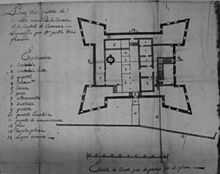
The Santa María de la Cabeza castle is a fortress built c. 1669–73 in the city of Cumaná on the orders of Sancho Fernando de Angulo y Sandoval, governor of the Province of Cumaná, as a replacement for the San Antonio de la Eminencia castle.[1] It is located in the center of the city next to St. Agnes Church, about 400 metres (1,300 ft) from the San Antonio castle, on a small hill.[2] The castle is square with bastions (designed by Angulo y Sandoval[3]) at its corners.[4] It has been described as having minor defensive capability.[5]
The castle was built using the trace italienne style popular during the seventeenth century; its floor has a geometric design, and bastions are the main defensive elements. However, unlike other permanent bastioned fortifications, its defensive walls were designed as two sections:[6] the lower part of the wall is vertical (perpendicular to the base) and the upper part, above the string course, is inclined inwards. This design makes the fort unique in Venezuela;[6] in most castles, the lower portion of the walls inclines outwards at the base and the upper parts are vertical (perpendicular to the base).
The primary material used to create the bricks for the castle was margosa limestone (a type of sedimentary rock composed of limestone and clay). The front of the castle is oriented to the east, and there was a ditch around the entire perimeter, including between the castle and the Plaza de Armas (Weapons Square).[6] As of 2008 the building had lost its parapets and shelters, but the main defensive structures and walls have been preserved.[6] The fort housed a garrison of 250 soldiers,[7] and was the residence of the governor of the Province of Cumaná.[8]
Origins
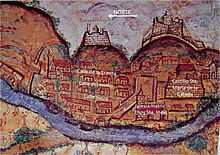
On 22 November 1668, Don Juan de Urtarte (governor of the province from 9 June 1668 to 26 July 1669)[9] wrote a memorandum to the King of Spain stating that Fort Santiago was unfit for defense because of its round shape and its mud and stone construction. Several years later, Governor Don Sancho Fernando de Angulo y Sandoval began—without authorization from the war council—construction of a new fortress with the rationale that the San Antonio de la Eminencia castle did not meet the city's defensive requirements, as it is located on a hilltop far from the city and the coast. The governor claimed that the castle also lacked a suitable water supply and accommodation for soldiers, and thus was unable to resist prolonged sieges.[3]
Unlike his predecessor Urtarte, who requested financing to supply and improve San Antonio, Angulo y Sandoval decided to build a new castle, one better able to defend the city than the two existing fortifications. The resulting fortress was called Santa María de la Cabeza; the governor then requested that the two older structures be demolished.[3]
History
On 4 May 1684 an earthquake devastated the city, severely damaging the Santa María castle.[3][10] A road linking the Santa María de la Cabeza and San Antonio de la Eminencia castles was mentioned by Agustín Crame in a 1777 proposal for the defense of the city. Crame opposed the idea, but stated that if a road were built it should be a gravel one.[6] The Santa María de la Cabeza castle was partially destroyed in a powerful earthquake felt throughout the state in 1797.[11]
After an earthquake in 1853, the reliquary enclosing an image of Nuestra Señora del Carmen (Our Lady of Mount Carmel), originally situated at the Mount Carmel chapel, was moved to the Santa María de la Cabeza castle, where Santos Berrizbeitia built a new chapel in 1912 to protect the image; it was later moved to St. Agnes Church. The ditch was filled in for construction of the Mount Carmel chapel and the deteriorated parapets were demolished. The original slopes and terraces present on Diaz Fajardo's 1737 map were probably also buried in the process. The chapel in the castle was the final resting place for Berrizbeitia; his remains, originally interred at Holy Trinity Cemetery (which he had built), were exhumed and moved five years after his death.[6][12]
Between the late eighteenth and early nineteenth centuries, Cumaná experienced an increase in population. The areas around the castles and the Manzanares River became densely populated. New buildings were constructed that were attached to the castle walls, completely closing off the perimeter and making direct access impossible.[6] Another earthquake in 1929 left the structure in ruins and rendered it unusable.[13][14] The offices of the seat of government for the Province of Cumaná were moved elsewhere and the building was abandoned.[8][15] The castle was declared a Cultural and Municipal Asset in May 2005 by the state Cultural Assets Institute.[6]
Gallery
Further reading
- "Edificaciones Militares" (PDF) (in Spanish). Gobierno del Estado Sucre. Retrieved 3 January 2013.
- "Ruta Histórico Cultural" (in Spanish). GuiaViajesVirtual. Retrieved 7 January 2013.
- Audemard, Frank; Altez, Rogelio (August 2008). "El sismo de 1629 en cumaná: Aportes para una nueva historia sísmica del oriente venezolano". IMME (in Spanish) 46 (2) (Venezuela: Scientific Electronic Library Online). pp. 53–71. ISSN 0376-723X. Retrieved 7 January 2013.
References
- ↑ Arellano, Fernando (1988). El Arte Hispanoamericano (in Spanish). Universidad Catolica Andres. p. 237. ISBN 9789802440177. Retrieved 6 January 2013.
- ↑ Museo Mitre (1913). Documentos del Archivo de Belgrano (in Spanish) 2. Buenos Aires: Coni hermanos. p. 533. Retrieved 7 January 2013.
- ↑ 3.0 3.1 3.2 3.3 "Fortaleza de San Antonio de la Eminencia". CorsoTur. Archived from the original on 3 January 2013. Retrieved 3 January 2013.
- ↑ de Alcedo, Antonio (1786). Diccionario geográfico-histórico de las Indias Occidentales ó América (in Spanish). Imprenta de Benito Cano. p. 722. Retrieved 6 January 2013.
- ↑ Luis Navarro García, Luis Suárez Fernández (1983). Historia general de España y América (in Spanish) 11. Ediciones Rialp. p. 113. ISBN 9788432121074. Retrieved 6 January 2013.
- ↑ 6.0 6.1 6.2 6.3 6.4 6.5 6.6 6.7 Oropeza, Ana Teresa (6 July 2008). "La cámara viajera de Henrique Avril". Diario de Sucre (in Spanish). Centro UNESCO Amigos de la Herencia Cultural del Estado Sucre. Retrieved 7 January 2013.
- ↑ Greenberg, Arnold (1997). "Venezuela Alive". Hunter Travel Guides (3 ed.). Hunter Publishing, Inc. p. 176. ISBN 9781556508004. Retrieved 7 January 2013.
- ↑ 8.0 8.1 "Cumaná, Estado Sucre". Disfrute Venezuela (in Spanish). Portales Turísticos de Venezuela. Retrieved 7 January 2013.
- ↑ Buenaventura de Carrocera (1972). Mision de Los Capuchinos en Los Llanos de Caracas (in Spanish). Academia Nacional de la Historia. p. 26. Retrieved 5 January 2013.
- ↑ Beauperthuy Urich, Luis Daniel (December 2006). "Análisis histórico de las amenazas sísmicas y geológicas de la ciudad de Cumaná, Venezuela". Revista de la Facultad de Ingeniería 21 (4). Universidad Central de Venezuela. pp. 113–15. ISSN 0798-4065.
- ↑ Redacción (7 January 2006). "14 de Diciembre" (in Spanish). En Oriente. Retrieved 7 January 2013.
- ↑ González Bruzual, Luis Gerardo (1 January 2008). "Memoria Fotográfica de la Ciudad de Cumaná / Iglesia de Santa Inés". Diario de Sucre (in Spanish). Centro UNESCO Amigos de la Herencia Cultural del Estado Sucre. Retrieved 7 January 2013.
- ↑ "Fuerte Santa María de la Cabeza ::: Cumaná" (in Spanish). ExpoSucre. Retrieved 7 January 2013.
- ↑ "Castillo Santa Maria de la Cabeza" (in Spanish). Oriente Web. Retrieved 7 January 2013.
- ↑ Caulín, Antonio (1779). Juan de San Martin, ed. Historia Coro-Graphica Natural y Evangelica de la Nueva Andalucia, Provincias de Cumana, Guayana y Vertientes del Rio Orinoco (in Spanish). Biblioteca Estatal de Baviera. p. 126. Retrieved 7 January 2013.
| ||||||||||||||||||||||||
